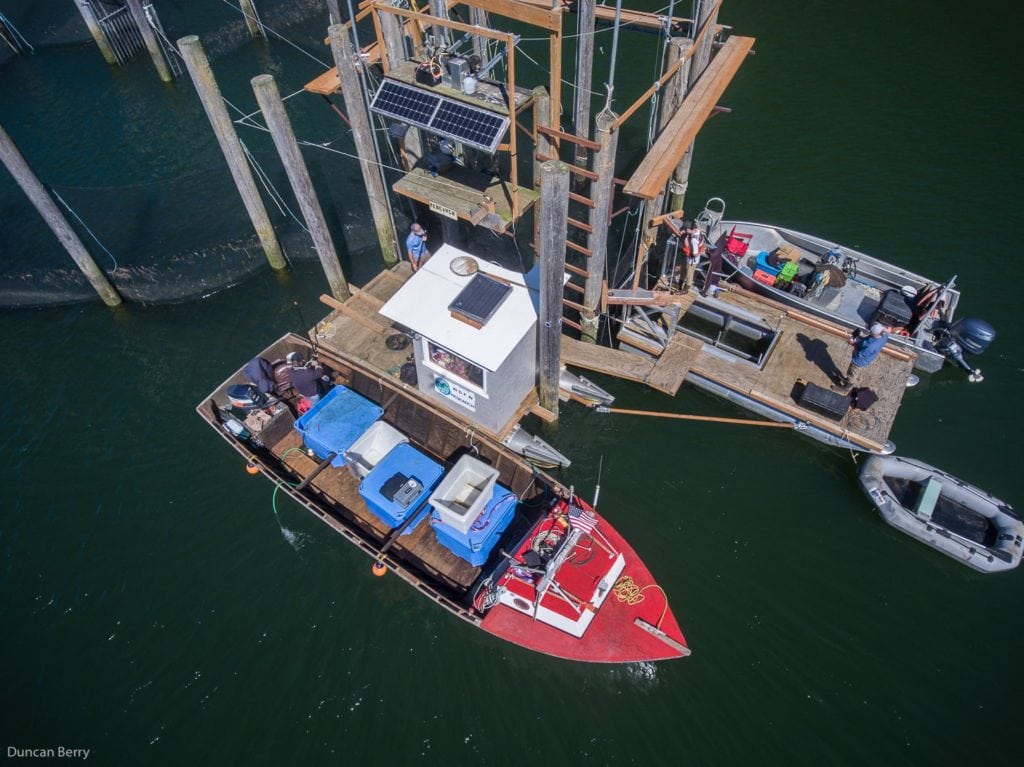We are pleased to announce that Wild Fish Conservancy’s (WFC) 2019 fish trap research has been peer-reviewed and published in the North American Journal of Fisheries Management! This is the second of such journal publications resulting from WFC’s research of the alternative fishing gear in the lower Columbia River, adding to a wealth of information available in published reports and theses. More than ever before, WFC’s recent results suggest that fish traps have significant potential to benefit wild salmon recovery and sustainable fisheries by reducing bycatch mortality and hatchery impacts to wild salmonids in mixed-stock commercial fisheries of the Pacific Northwest.

Expanding upon WFC’s research of the prototype fish trap design between 2016 and 2018, an experimental commercial fish trap was further modified in 2019 to largely eliminate net contact, air exposure, handling, and crowding of fishes (factors known to impact survival of wild salmonid bycatch). Studies were conducted from May to November 2019 in the lower Columbia River to estimate survival of bycatch and evaluate potential benefits from the modified passive capture design. Analyzed through two separate survival estimation techniques, the modified trap demonstrated no detectable effect on salmon release survival and a significant improvement over the previous prototype design. Estimated through a paired release-recapture methodology, the relative survival effect of catch and release compared to controls over a 400-km migration was 1.017 (SE = 0.032) for adult sockeye salmon. For adult coho salmon held captive for a 48-h post-release period, survival was 1.000 (CI (S ≥ 0.978) = 0.95). These published results from the North American Journal of Fisheries Management suggest that trap modifications can be made to significantly reduce bycatch mortality of ESA-listed salmonids and provide increased selective harvest opportunity for hatchery-origin salmonids.

Building upon these peer-reviewed and published results, WFC biologists are actively researching the modified fish trap yet-again this season to further confirm results of the 2019 coho salmon survival study. This research has been requested by Columbia River management agencies that ironically approve conventional gill net fisheries on an annual basis in the complete absence of release mortality data for critical bycatch stocks (e.g., wild steelhead). Despite clear bias in harvest management and gear approval processes, WFC is proud to conduct further research on alternative gears. As a science-based non-profit conservation organization, we firmly believe that data should guide management decisions, and more data for the fish trap this season should only help management agencies make logical and informed decisions for the future of Columbia River salmon fisheries.
Although WFC’s 2020 coho salmon study remains in progress, results to date continue to demonstrate that the modified passive fish trap design has no detectable impact on wild salmonid bycatch survival. After holding two samples of coho salmon (totaling 76 fish) over a 96-hour post-release duration, there have been zero mortalities. Similar to published findings from 2019, these impressive bycatch survival results have not been achieved for any commercial or recreational gear previously studied in the lower Columbia River. Prior to the conclusion of this year’s field research season, WFC plans to complete two additional holding samples to increase the precision of the present bycatch survival estimate for wild coho salmon.

With the announcement of this major journal publication and promising preliminary results from this year’s coho salmon research, WFC would like to thank our funders and supporters for making all of this important work possible: the National Oceanic and Atmospheric Administration (NOAA) Fisheries Service (in cooperation with the National Bycatch Reduction Engineering Program and the Saltonstall-Kennedy Grant Program), the Washington Department of Fish and Wildlife, Patagonia, Inc., the Raynier Foundation, the Looking Out Foundation, the Seattle Aquarium, and generous members of Wild Fish Conservancy.
Addressing severely entrenched harvest and hatchery problems in Pacific Northwest salmon fisheries is undoubtedly a daunting task. However, with the unwavering dedication of our research staff and support from people like you, the status-quo can be changed and wild salmon recovery achieved in the Columbia Basin and elsewhere across the Pacific Northwest.
See the modified passive chamber design in action below:
Join our mailing list to recieve important updates on our work, the latest wild fish news, & opportunities to take action to support wild fish.
This site is protected by reCAPTCHA and the Google Privacy Policy and Terms of Service apply.
Wild Fish Conservancy is recognized as a 501(c)3 non-profit by the IRS